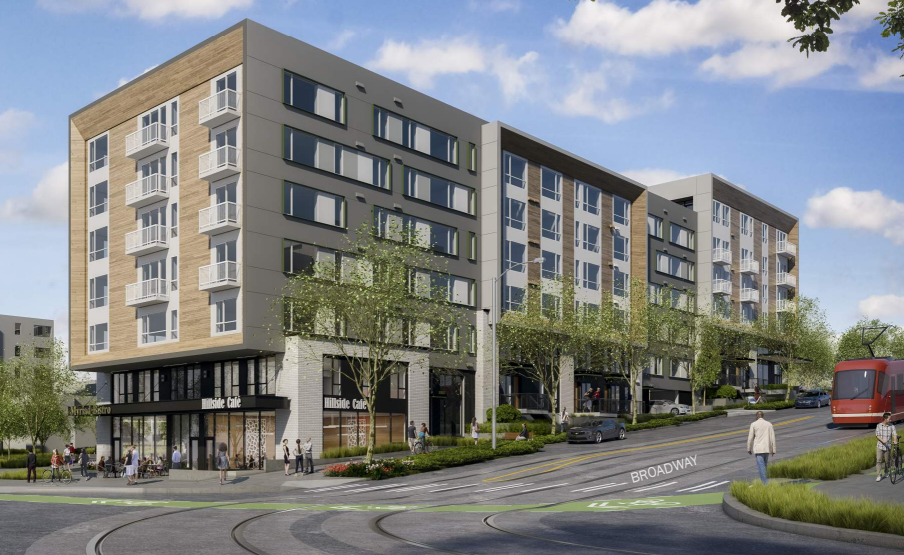Redevelopment of Yesler Terrace continues in earnest, and it doesn’t appear that there will be any end in sight soon. The local design review board will take one final pass of Block 2E tomorrow, a 1-acre development site right in the heart of the community. Vulcan Real Estate, which bought the property last year, is planning a 7-story, 195-unit mixed-use building. That acquisition was part of a larger land sale from the Seattle Housing Authority, which totaled 3.7 acres for $22 million. Vulcan has given Runberg Architecture Group, a local firm, the reigns of project design.
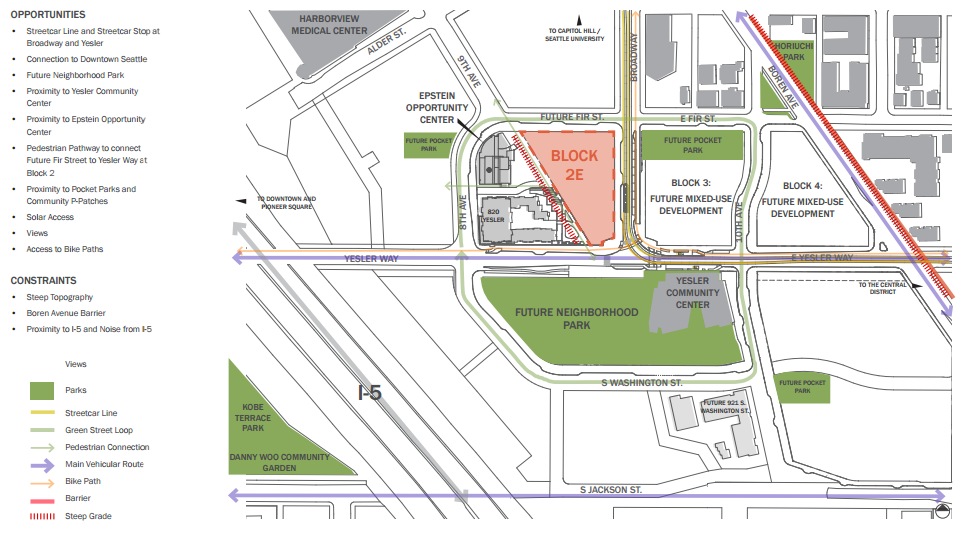
In May, I covered the original project concept for Block 2E, and its sister project across the street, Block 3. Three separate options were evaluated at that time, with the design review board giving their blessing for refinement of Vulcan’s preferred option. Broadly speaking, the massing of that option looks a lot like a reversed “F” with interrupted facades. This comes from the incorporation of a visible courtyard on the west side and targeted modulation techniques. The architects suggest that this design approach will break down the building massing along the interior pedestrian path, mimic the rhythm of the terrace, capitalize on local and territorial views, and promote common massing along Broadway in anticipation of Block 3’s development across the street.
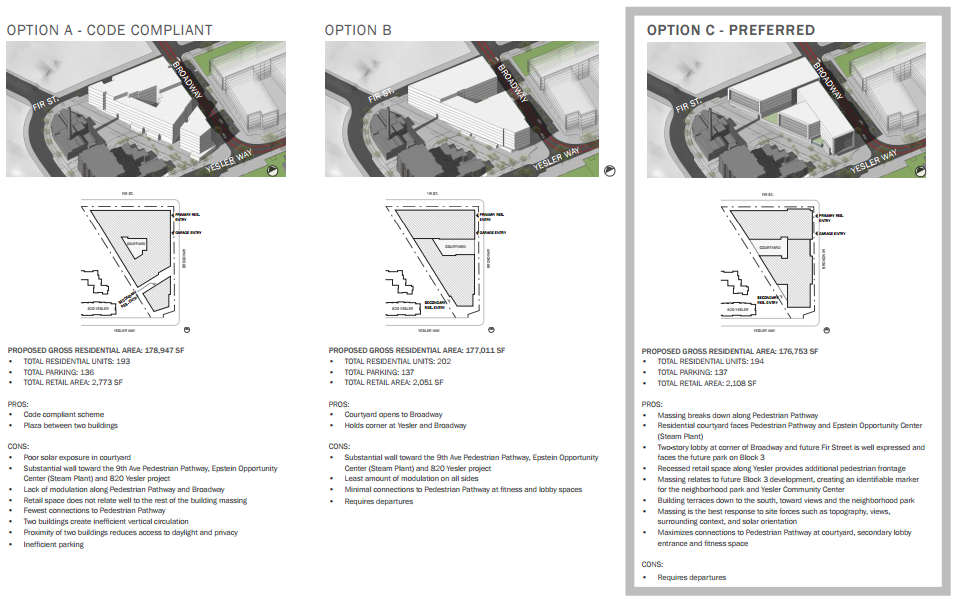
Vulcan has put a special emphasis on apartments. Plans call for 194 apartment units across the upper five floors of the building. Initial floor plans suggest that units will differ significantly in size and style. Some units will be built for families, but a majority appear to be geared toward studios and one-bedrooms. The diagonal west frontage has forced angular shapes to be created along portions of the building. The architects have decided to run with this despite the resulting oddly shaped units. Indeed, many of the units are very atypical and some of the space may be less usable, but if nothing else, that simply adds to individual interest of them. Baked into the plans are a range of onsite amenities for residents. Those include a roof top deck, fitness center, courtyard, bike storage rooms, and community spaces for reading, cooking, and lounging. Not to be outdone, a 127-stall underground parking garage will also be provided.
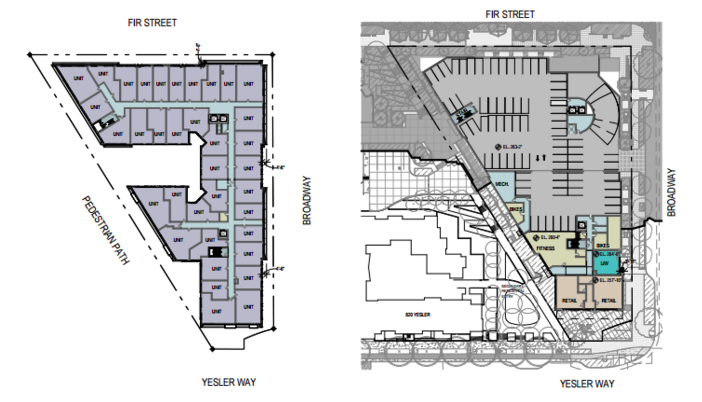
The project isn’t all apartments though. Commercial spaces will also find their way into the development with a live-work unit and two retail spaces slated for the southern frontages of Block 2E. Renderings show both primary ground floor retail spaces opening up onto Yesler Way and totaling about 2,400 square feet. That’s an upward revision from the original project concept, which capped out at around 2,100 square feet for ground floor retail. The architects have planned a deeply setback corner that will likely enhance the retails spaces. Renderings suggest that the retail spaces could be restaurant uses, which would fit nicely with the semi-landscaped plaza.
Meanwhile, the sole live-work unit will front on Broadway, just north of the corner retail unit. Those spaces are known to be a challenge to fill with regular businesses, but perhaps the foot traffic along Yesler Way, proximity to a growing commercial district, and singular nature of it will ensure greater success.
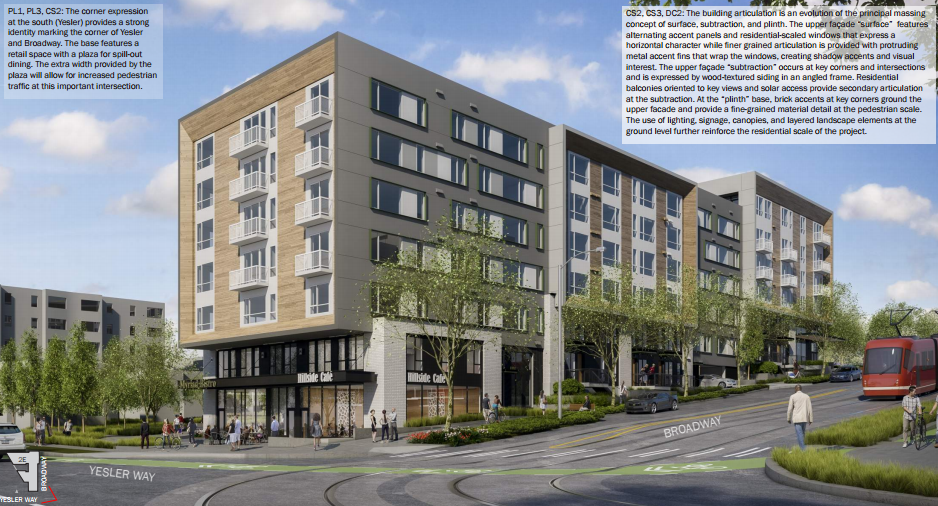
On the design front, the architects have developed a building with multiple dimensions using three central concepts: plinth, surface, and subtraction.
- The first dimension of the building is the plinth. Think of the plinth as the base of the structure. Columns and solid beams hold up the larger structure above. This is visible with the white brick, black canopies, vertical windows, and black panels that fill the spaces in between. Plinths are a smaller scale and more regular than that the block facades above.
- The second dimension is surface. Architects wanted to devise a massing that was broken up to keep the upper floors visually interesting. Surface is the base layer of those facades with dark grey paneling and horizontally staggered window boxes. Even the windows themselves have staggered paneling within them. To accent the paneling, white and light grey tones are applied to the their surface. Perhaps a less noticeable detail, a green metallic accent lines the outer frame of the windows boxes.
- The third dimension is subtraction. That design element implements boxy projections to frame sections of the building. Subtraction is more regular than surface because of the gridded theming incorporated into it. Windows form vertical columns from top to bottom, and while window style can differ slightly from column to column, all windows within a column are identical in basic design. Inlaid between those columns are horizontal planks of wood. The architects have chosen a woody light brown color for the planks, which is wonderfully balanced with the white paneling around the windows. Together, they make the building feel very light.
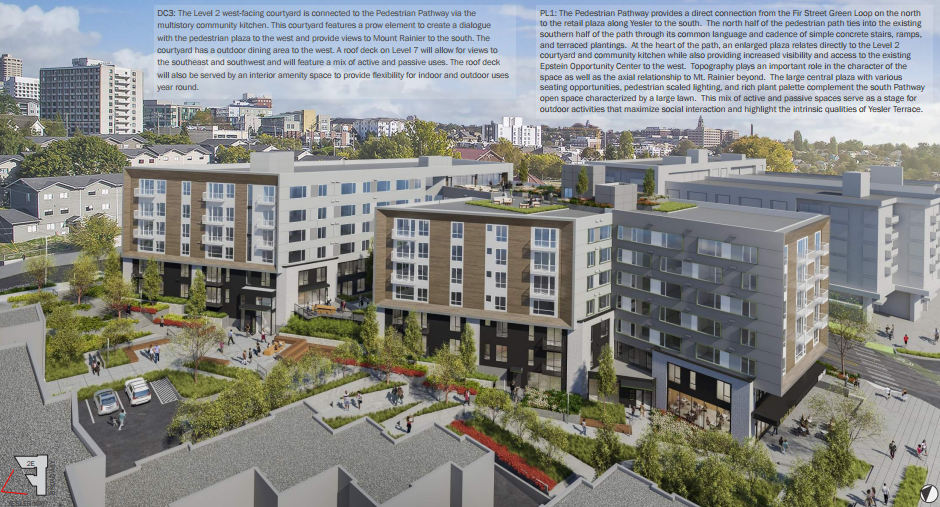
Block 2E will provide extensive public realm improvements to Yesler Terrace, including: new streetscapes, two plazas (the first discussed above), and a completed alleyway path. Some of the planned streetscape improvements have already been installed thanks to the First Hill Streetcar project. Those include the streetcar track itself, a cycletrack, on-street parking, and the sidewalk along Broadway. Vulcan, however, will still be responsible for expanding the width of the sidewalk, adding curb bulbs, and installing minor landscaping strips along Broadway. The lion’s share of their streetscape improvements will be focused on a non-existent Fir St and the Yesler Way plaza space. Vulcan will have to build the entire length of the east-west Fir St from Broadway to 9th Ave (as shown below).
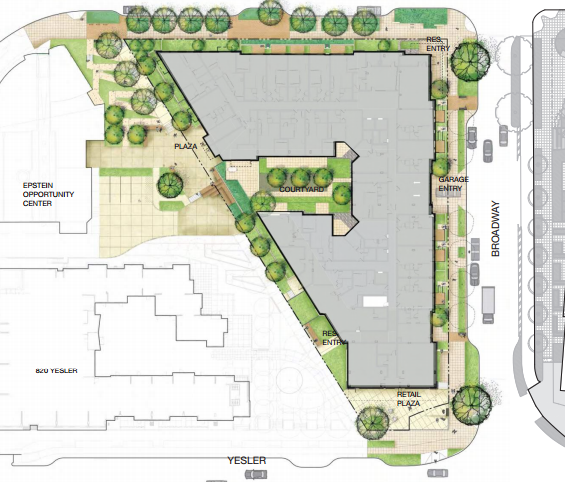
Meanwhile, work on the alleyway path has already begun as part of the 820 Yesler project, but Block 2E will add on to this by completing the northern half of the path and complimenting the southern portion with perimeter landscaping. The alleyway is an especially unique feature because it continues the 9th Ave axis, which stretches in a northwest-southeast direction. The grade change is quite substantial with the slope heading downward as the pathway moves southeast. Designers have gone with a terraced approach to make those grade changes gentle and interesting.
As the path zigzags, landscaping fills the in-between areas to create a beautiful garden feeling. Trees, shrubs, flowers, and concrete planter boxes reinforce the terrace ambiance. And in the middle, an open plaza area will provide a relief for passerby and residents. Architects hope that it will be a prime viewing spot for people to relax. Just to the west, the Epstein Opportunity Center will connect to the plaza and likely activate the space by community members. On an almost equal plane, the adjacent courtyard of Block 2E will face the plaza to provide a visual connection between the green spaces and offer a view toward the center of Block 2E. It’s a nice gesture, which should reduce the exclusiveness of the structure. But perhaps most importantly, the alleyway path will connect Yesler Way and 8th Ave/Fir St/9th Ave.
How To Get Involved
If you’re interested in attending the community design review meeting for this project, you can do so tomorrow (November 4th). The East Design Review Board will meet at Seattle University in the Admissions & Alumni Community Building, located at 824 12th Avenue. There will be simultaneous design review sessions for the respective projects beginning promptly at 6.30pm. Alternatively, if you wish submit comments in written form, you can do so by e-mailing Magda Hogness, Project Planner, at Magda.Hogness@seattle.gov and the Department of Planning and Development (DPD) at PRC@seattle.gov.
For more design review materials and upcoming meetings, see DPD’s design review page.
Stephen is a professional urban planner in Puget Sound with a passion for sustainable, livable, and diverse cities. He is especially interested in how policies, regulations, and programs can promote positive outcomes for communities. With stints in great cities like Bellingham and Cork, Stephen currently lives in Seattle. He primarily covers land use and transportation issues and has been with The Urbanist since 2014.


